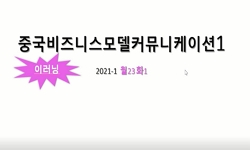In order to provide a deeper understanding of business communication methods to Koreans working in Japanese companies or Japanese working in Korean companies, this study analyzed the form of commissioned expressions in Korean and Japanese in problem s...
http://chineseinput.net/에서 pinyin(병음)방식으로 중국어를 변환할 수 있습니다.
변환된 중국어를 복사하여 사용하시면 됩니다.
- 中文 을 입력하시려면 zhongwen을 입력하시고 space를누르시면됩니다.
- 北京 을 입력하시려면 beijing을 입력하시고 space를 누르시면 됩니다.

비즈니스 커뮤니케이션에서 나타나는 한·일 의뢰표현 형식별 사용양상 -문제 상황 사례 장면을 중심으로- = The Use of Korean and Japanese Request Expressions in Business Communications -With a Focus on Problematic Situations-
한글로보기부가정보
다국어 초록 (Multilingual Abstract)
As a result, the expression form was used differently according to the upper and lower relationships, and the difference was also confirmed. In Korean and Japanese, the form of sentences ending with '~해,~봐,~아,~어' and '~て' in the direct request type was most often used when the boss instructed the subordinate. On the other hand, in Korean, the form of '~please give me, give me', which is a sentence ending in a direct request-type command type, was most often used by the subordinate to the boss, whereas in Japanese, the form of '~てもいいですか、~てもよろしいですか', which is an indirect request-type permitted sentence, was most often used by the subordinate to the boss.
In other words, in Korea, both the boss and the subordinate use the direct request type, but in Japanese, the boss uses the direct request type, while the subordinate uses the indirect request type higher. This trend is judged to be prominent in Japanese in order to effectively convey the request intention while considering the feelings of the boss. This phenomenon is more preferred in Japanese society, which can be attributed to the language view and mindset of Japanese culture. Additionally, the choice of request expression in the process of resolving urgent situations or conflicts, such as problem situations, depends on the context of the situation and the top-down relationship, and suggests that these factors must be well understood and utilized appropriately for effective communication.
In order to provide a deeper understanding of business communication methods to Koreans working in Japanese companies or Japanese working in Korean companies, this study analyzed the form of commissioned expressions in Korean and Japanese in problem situations, and considered changes in expression forms according to top and bottom relationships.
As a result, the expression form was used differently according to the upper and lower relationships, and the difference was also confirmed. In Korean and Japanese, the form of sentences ending with '~해,~봐,~아,~어' and '~て' in the direct request type was most often used when the boss instructed the subordinate. On the other hand, in Korean, the form of '~please give me, give me', which is a sentence ending in a direct request-type command type, was most often used by the subordinate to the boss, whereas in Japanese, the form of '~てもいいですか、~てもよろしいですか', which is an indirect request-type permitted sentence, was most often used by the subordinate to the boss.
In other words, in Korea, both the boss and the subordinate use the direct request type, but in Japanese, the boss uses the direct request type, while the subordinate uses the indirect request type higher. This trend is judged to be prominent in Japanese in order to effectively convey the request intention while considering the feelings of the boss. This phenomenon is more preferred in Japanese society, which can be attributed to the language view and mindset of Japanese culture. Additionally, the choice of request expression in the process of resolving urgent situations or conflicts, such as problem situations, depends on the context of the situation and the top-down relationship, and suggests that these factors must be well understood and utilized appropriately for effective communication.
동일학술지(권/호) 다른 논문
-
新聞コラムにおける外来語の使用傾向とその変遷 -5年間(2019年から2023年まで)のデータ分析を基に-
- 대한일어일문학회
- 키시모토 마리코
- 2024
- KCI등재
-
- 대한일어일문학회
- 張明哲
- 2024
- KCI등재
-
類義表現「てほしい」と「てもらいたい」の使用に関する一考察 -使用される場面を中心として-
- 대한일어일문학회
- 이현진
- 2024
- KCI등재
-
일본어 仮名의 한글 표기에 관하여 -한국의 외래어 표기법을 중심으로-
- 대한일어일문학회
- 한원형
- 2024
- KCI등재




 KCI
KCI DBpia
DBpia






